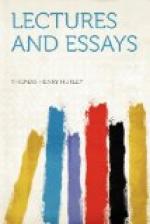The real state of the case, then, is that the agnostic “does not believe the authority” on which “these things” are stated, which authority is Jesus Christ. He is simply an old-fashioned “infidel” who is afraid to own to his right name. As “presbyter is priest writ large,” so is “agnostic” the mere Greek equivalent for the Latin “infidel.” There is an attractive simplicity about this solution of the problem; and it has that advantage of being somewhat offensive to the persons attacked, which is so dear to the less refined sort of controversialist. The agnostic says, “I cannot find good evidence that so and so is true.” “Ah,” says his adversary, seizing his opportunity, “then you declare that Jesus Christ was untruthful, for he said so and so;” a very telling method of rousing prejudice. But suppose that the value of the evidence as to what Jesus may have said and done, and as to the exact nature and scope of his authority, is just that which the agnostic finds it most difficult to determine. If I venture to doubt that the Duke of Wellington gave the command “Up, Guards, and at ’em!” at Waterloo, I do not think that even Dr. Wace would accuse me of disbelieving the Duke. Yet it would be just as reasonable to do this as to accuse any one of denying what Jesus said, before the preliminary question as to what he did say is settled.
Now, the question as to what Jesus really said and did is strictly a scientific problem, which is capable of solution by no other methods than those practised; by the historian and the literary critic. It is a problem of immense difficulty, which has occupied some of the best heads in Europe for the last century; and it is only of late years that their investigations have begun to converge towards one conclusion.[30]
That kind of faith which Dr. Wace describes and lauds is of no use here. Indeed, he himself takes pains to destroy its evidential value.
“What made the Mahommedan world? Trust and faith in the declarations and assurances of Mahommed. And what made the Christian world? Trust and faith in the declarations and assurances of Jesus Christ and His Apostles” (l.c. p. 253). The triumphant tone of this imaginary catechism leads me to suspect that its author has hardly appreciated its full import. Presumably, Dr. Wace regards Mahommed as an unbeliever, or, to use the term which he prefers, infidel; and considers that his assurances have given rise to a vast delusion which has led, and is leading, millions of men straight to everlasting punishment. And this being so, the “Trust and faith” which have “made the Mahommedan world,” in just the same sense as they have “made the Christian world,” must be trust and faith in falsehood. No man who has studied history, or even attended to the occurrences of everyday life, can doubt the enormous practical value of trust and faith; but as little will he be inclined to deny that this practical value has not the least relation to the reality of the objects of that trust and faith. In examples of patient constancy of faith and of unswerving trust, the “Acta Martyrum” do not excel the annals of Babism.[31]




